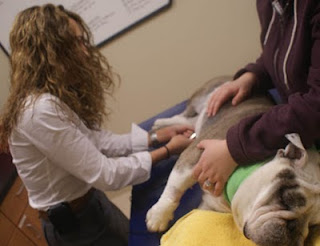Scottie is a very special male 7-year-old Pembroke Welsh Corgi who has previously enjoyed Championships in multiple US and Canadian dog shows. He has also received titles for herding ducks and sheep. Unfortunately, Scottie's owner, Mari Carroll, noticed over the past few weeks that he had become exercise intolerant and less interested in playing with the other dogs in the household. Scottie was brought to his regular vet for an exam. While at the vet's office, he suffered four fainting episodes (syncope). The results of an electrocardiogram (ECG) were cause for concern and Scottie's veterinarian immediately referred him to the Emergency and Critical Care service of Cornell University Veterinary Specialists (CUVS) for a consultation with cardiologist Dr. Mandi Kleman, DVM, DACVIM (Cardiology).
Upon arriving at CUVS, Scottie experienced another episode of fainting and collapse, and he was immediately brought into the Emergency service for stabilization under the care of Dr. Sergi Serrano, LV, DVM, DACVECC. A repeat ECG showed complete heart block. After discussing all of the options with the owners, Dr. Serrano admitted Scottie for a diagnostic workup with the intention of Dr. Kleman implanting a pacemaker.
Scottie's initial diagnostic workup included bloodwork, a urinalysis and an echocardiogram. Due to the additional findings during Scottie's physical exam, an abdominal ultrasound was performed by CUVS board certified internist Dr. Forman DVM, DACVIM (Internal Medicine) prior to pacemaker implantation.
Dr. Kleman implanting Scottie's pacemaker.
At this point, Scottie was a good candidate for emergency pacemaker implantation, and Dr. Kleman was prepared for the procedure. The 75-minute implantation procedure went smoothly and Scottie was kept overnight for post-surgical monitoring. The next day, Dr. Kleman performed a chest x-ray, another ECG, and programmed the pacemaker to optimize the settings. Programming the pacemaker, as well as periodic evaluations of the pacemaker's function, can be achieved with no sedation and absolutely no discomfort for the animal. Scottie laid down on a bed in ICU and enjoyed a head scratching (care of our technicians) as Dr. Kleman programmed the pacemaker with her laptop computer and a remote control.
Scottie's x-ray (radiograph) taken the day after surgery showing the pacemaker's location.
It should be noted that the total amount of time that elapsed between Scottie's arrival at CUVS and the end of Dr. Kleman's pacemaker implantation procedure was only about 7 hours- a testament to the speed, accuracy and flexibility that is only possible at a state-of-the-art animal hospital such as CUVS.
Dr. Kleman, DVM, DACVIM (Cardiology) and Nicole VanSant, BS, LVT, VTS (ECC) examine Scottie the day after his pacemaker implantation.
“Pacemaker implantation in dogs and cats is not uncommon. Hundreds of pacemakers are implanted in the U.S. each year by veterinary cardiologists,” says Dr. Kleman. “Pacemaker implantation in dogs and cats is also not as expensive as one might think.” The cost of the procedure is comparable to an orthopedic surgery on a dog’s knee or back. Additionally, the procedure is minimally invasive, with the pacemaker implanted through a superficial vein.
 |
| Scottie, bright, alert and happy the day after his pacemaker implantation. |
The patient recovers from the procedure with instant clinical improvement. The heart rate is restored to normal and the heart can provide enough oxygen-rich blood to the pet's body. The rechecks are not difficult for the pet or the owner. It can be expected that the typical pacemaker only needs to be programmed two to three times in the first year, and once per year after that.
Please click on the image above to see an enlarged version.
We were thrilled that we could provide the necessary care to another dog with complete heart block. Scottie was a remarkable patient and our affection for him was trumped only by the joy on Mari's face as he was discharged from CUVS the following day.
Dr. Kleman, DVM, DACVIM (Cardiology) Nicole VanSant, BS, LVT, VTS (ECC), Scottie & Scottie's mom Mari at discharge.
Nicole, Dr. Kleman, Scottie & Scottie's mom Mari at discharge.
To learn more about pacemakers, click here.













